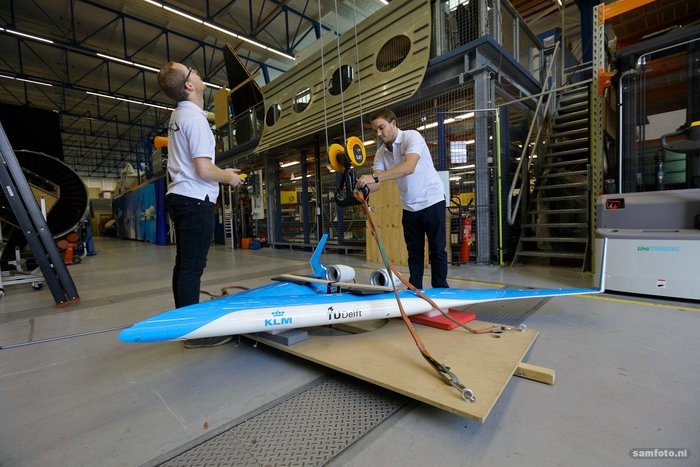Flying in a V-shaped wing
Air traffic accounts for approximately 2.5% of greenhouse gas emissions. However, TU Delft researchers think it can be made more sustainable. They are developing a totally new kind of aircraft: the Flying-V.
In it, the cabin, cargo hold and fuel tanks are integrated in the wing. The entire aircraft is in fact a single V-shaped wing. Last summer, a 3-meter-wide radio-controlled scale model took its maiden flight on an airfield in Germany. The Flying-V picked up speed, lifted its pointed nose into the air and soon began to climb. The test ran relatively smoothly, although it had a rough landing. It landed on its nose wheel, which broke off.
The plane's more aerodynamic shape and lower weight means it should consume 20% less fuel than the Airbus A350, which serves as a reference. The Flying-V should be able to carry the same number of passengers (314) and the same volume of cargo (160 m3).
KLM and Airbus have been closely involved in the research. If the aircraft is ever used in civil aviation, AE Dean Henri Werij believes it will be “the most revolutionary change in aviation since the introduction of the jet engine.” He said this in a webcast during the presentation of the test flight.
A 20% reduction in energy consumption is quite impressive but still not enough to help achieve the climate targets, so the researchers are exploring the possibility of alternative, greener fuels, such as biofuel and synthetic kerosene.
“Ultimately, we’ll need to fly completely on renewable energy”, says Werij. “If CO2 is also released during the flight, for example because we fly on synthetic kerosene, the same amount of CO2 will be used to make the fuels. At TU Delft, we’re investigating how we can achieve that.”
Even if you make advances in the development of batteries, it’s still difficult to compete with kerosine
We will have a long wait for large passenger aircraft that can fly on batteries. The greatest obstacle is the gravimetric energy density: the amount of energy in a kilo of material. “Currently, 50 times as much energy goes into a kilo of kerosene as in a battery”, explained TU Delft aviation researcher Joris Melkert in a recent interview in Trouw. “You can improve efficiency thanks to the electric engine that replaces the combustion engine in an electric aircraft, but kerosene is still 20 times as efficient. In other words, even if you make advances in the development of batteries, it’s still difficult to compete with kerosene.”
More information: tudelft.nl/lr/flying-v

